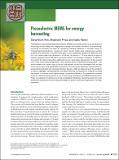Piezoelectric MEMS for energy harvesting
Author(s)
Kim, Sang-Gook; Priya, Shashank; Kanno, Isaku
DownloadMRS bulletin Energy Harvesting.pdf (803.6Kb)
PUBLISHER_POLICY
Publisher Policy
Article is made available in accordance with the publisher's policy and may be subject to US copyright law. Please refer to the publisher's site for terms of use.
Terms of use
Metadata
Show full item recordAbstract
Piezoelectric microelectromechanical systems (MEMS) have been proven to be an attractive technology for harvesting small magnitudes of energy from ambient vibrations. This technology promises to eliminate the need for replacing chemical batteries or complex wiring in microsensors/microsystems, moving us closer toward battery-less autonomous sensors systems and networks. To achieve this goal, a fully assembled energy harvester the size of a US quarter dollar coin (diameter = 24.26 mm, thickness = 1.75 mm) should be able to robustly generate about 100 μW of continuous power from ambient vibrations. In addition, the cost of the device should be sufficiently low for mass scale deployment. At the present time, most of the devices reported in the literature do not meet these requirements. This article reviews the current state of the art with respect to the key challenges such as high power density and wide bandwidth of operation. This article also describes improvements in piezoelectric materials and resonator structure design, which are believed to be the solutions to these challenges. Epitaxial growth and grain texturing of piezoelectric materials is being developed to achieve much higher energy conversion efficiency. For embedded medical systems, lead-free piezoelectric thin films are being developed, and MEMS processes for these new classes of materials are being investigated. Nonlinear resonating beams for wide bandwidth resonance are also being developed to enable more robust operation of energy harvesters.
Date issued
2012-11Department
Massachusetts Institute of Technology. Department of Mechanical EngineeringJournal
MRS Bulletin
Publisher
Cambridge University Press (Materials Research Society)
Citation
Kim, Sang-Gook, Shashank Priya, and Isaku Kanno. “Piezoelectric MEMS for Energy Harvesting.” MRS Bulletin 37.11 (2012): 1039–1050. Web.© Materials Research Society 2012.
Version: Final published version
ISSN
0883-7694
1938-1425